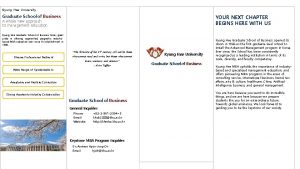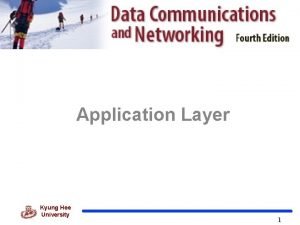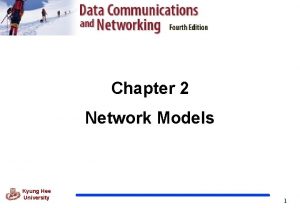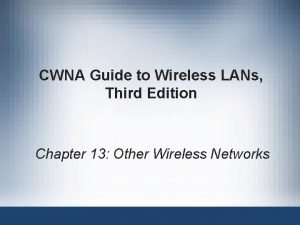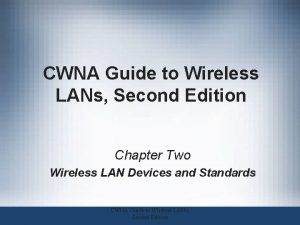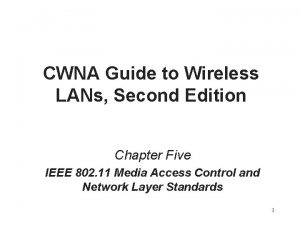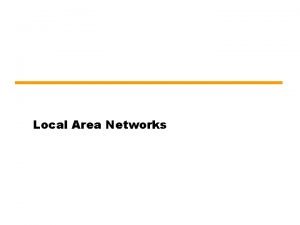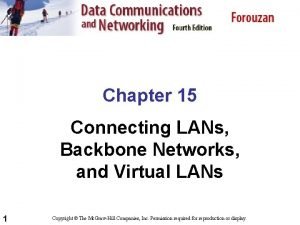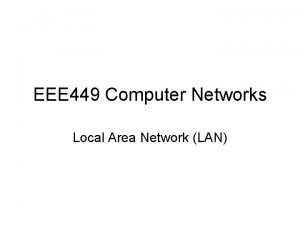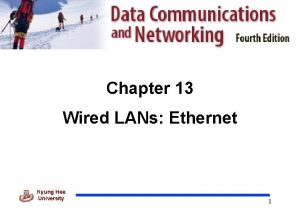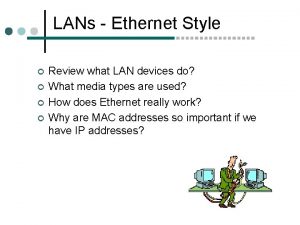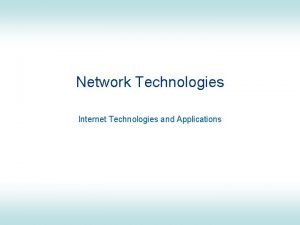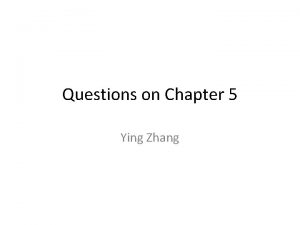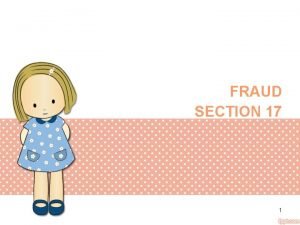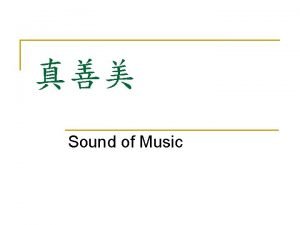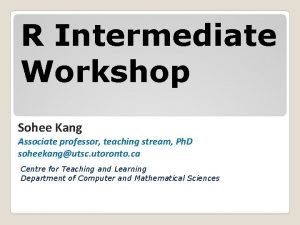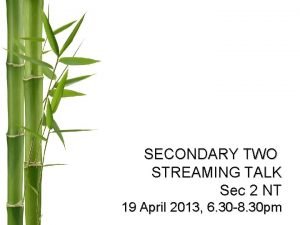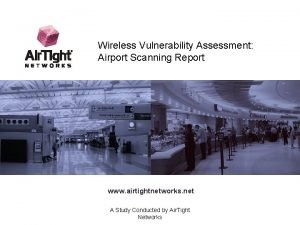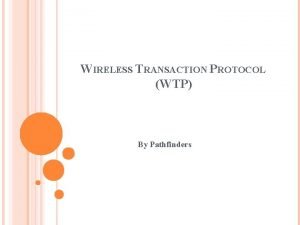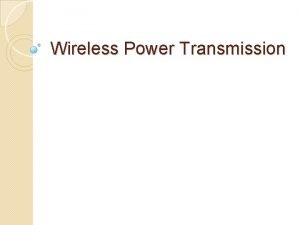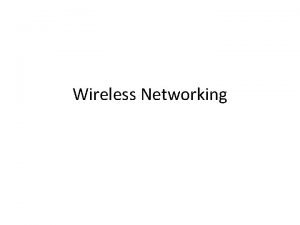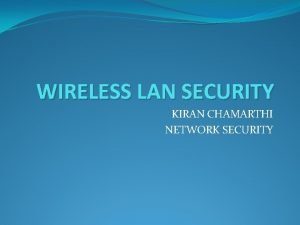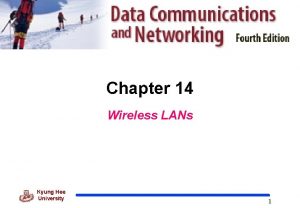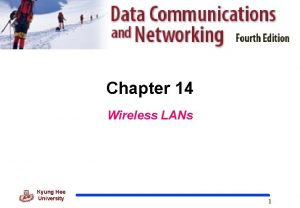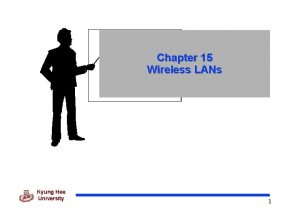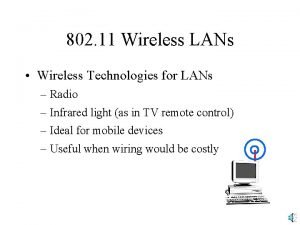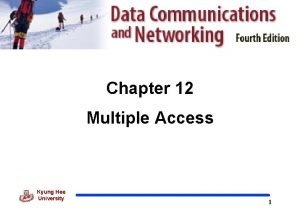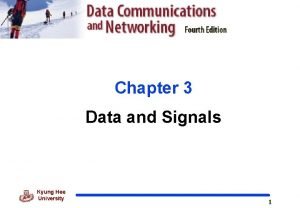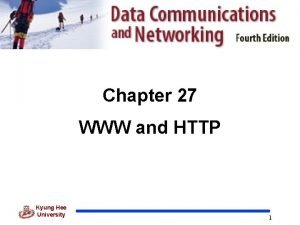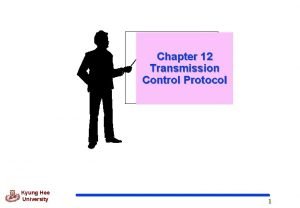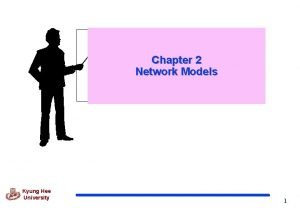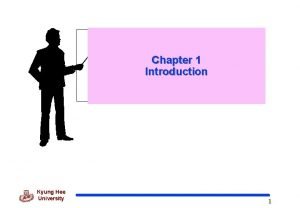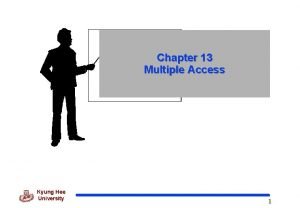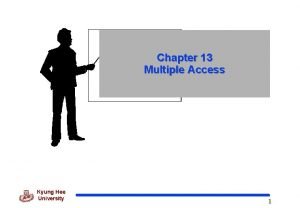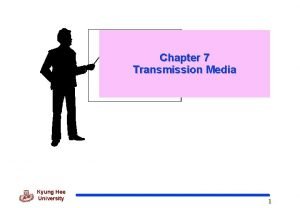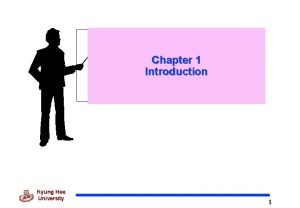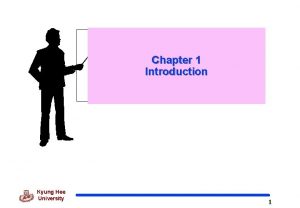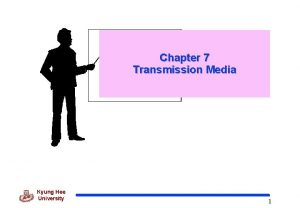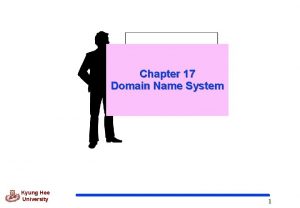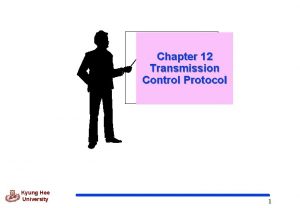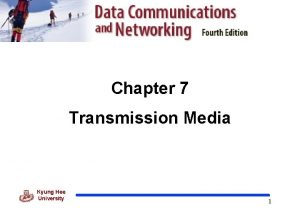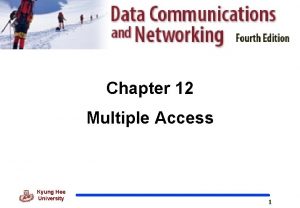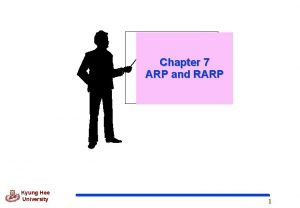Chapter 15 Wireless LANs Kyung Hee University 1









































- Slides: 41

Chapter 15 Wireless LANs Kyung Hee University 1

IEEE 802 Standards Working Groups Wi. MAX, an acronym that stands for Worldwide Interoperability for Microwave Access(802. 16) Wi. Fi (Wireless Fidelity) : 802. 11 Kyung Hee University 2

Introduction v Architecture v Physical Layer v MAC Layer v Addressing Mechanism Kyung Hee University 3

15. 1 IEEE 802. 11 - Architecture q Basic Service Set (BSS) q Extended Service Set (ESS) Kyung Hee University 4

Basic Service Set • made up of stationary or mobile wireless stations, and possibly a central base station (access point) • BSS without an AP is stand-alone, cannot send data to other BSSs Kyung Hee University 5

ESS – Extended Service Set q Made up of two or more BSSs with APs – connected through a distribution system (usually a wired LAN) Kyung Hee University 6

Station Types q No-transition mobility – either stationary or moving only inside a BSS q BSS-transition mobility – can move from one BSS to another, confined to one ESS q ESS-transition mobility – can move from one ESS to another Kyung Hee University 7

Physical layer specifications q 802. 11 defines the specs for the conversion of bits to a signal Kyung Hee University 8

FHSS – Frequency hopping spread spectrum q sender sends on one carrier frequency for a short amount of time, hops to another frequency for the same time, then another, and so on, eventually the cycle is repeated q makes it difficult for unauthorized person to make sense of data q 2. 4 GHz industrial, scientific, and medical (ISM) band – 79 subbands of 1 MHz q modulation is FSK (two-level or four-level) Kyung Hee University 9

Frequency-Hopping example q Kyung Hee University 10

DSSS – direct sequence spread spectrum q Each bit sent is replaced by a chip code (similar to CDMA, but this is at the physical layer, not a multipleaccess data link layer method) q 2. 4 GHz ISM band q Modulation is PSK (BPSK or QPSK) Kyung Hee University 11

802. 11 q 802. 11 Infrared v. Two capacities 1 Mbps or 2 Mbps. v. Range is 10 to 20 meters and cannot penetrate walls. v. Does not work outdoors. q 802. 11 FHSS (Frequence Hopping Spread Spectrum) v. The main issue is multipath fading. v 79 non-overlapping channels, each 1 Mhz wide at low end of 2. 4 GHz ISM band. v. Same pseudo-random number generator used by all stations. v. Dwell time: min. time on channel before hopping (400 msec). Kyung Hee University 12

801. 11 a, b, g q 802. 11 a OFDM – orthogonal frequency division multiplexing v 5 -GHz ISM band v 48 subbands for sending 48 groups of bits at a time, 4 subbands for control information v PSK for 18 Mbps and QAM for 54 Mbps q 802. 11 b HR-DSSS – high-rate direct sequence spread spectrum v 2. 4 GHz band v similar to DSSS except for encoding, complementary code keying (CCK), encodes 4 or 8 bits to one CCK symbol v modulation BPSK and QPSK v 4 data rates (1, 2, 5. 5, and 11 Mbps) : DSSS for 1, 2 Mbps, BPSKllfor 5. 5, QPSK for 11 Mbps v. Range is 7 times greater than 11 a. q Kyung Hee University 802. 11 b and 11 a are incompatible!! 13

801. 11 a, b, g (cont’d) q 802. 11 g OFDM v 2. 4 GHz band v 54 -Mbps data rate v Is backward compatible with 802. 11 b. Kyung Hee University 14

MAC layers in IEEE 802. 11 standard PCF : Point Coordination Function DCF : Distributed Coordination Function Kyung Hee University 15

CSMA/CA q Cannot implement CSMA/CD: v collision detection implies the ability to send and receive at the same time, which implies costly stations and increased bandwidth requirements v collision may not be detected because of a hidden terminal v distance could cause signal fading which could prevent a station from hearing a collision Kyung Hee University 16

Hidden and Exposed Terminals q (a)The hidden station problem Kyung Hee University (b) The exposed station problem 17

CSMA/CA flowchart Kyung Hee University 18

CSMA/CA and NAV DIFS – distributed interframe spread NAV – network allocation vector SIFS – short interframe spread collision only occurs during RTS – request to send handshake period (RTS, CTS) CTS – clear to send Kyung Hee University 19

Frame format Kyung Hee University 20

Subfields in FC(frame control) field Field Explanation Version The current version is 0. Type of information: management (00), control (01), or data (10). Subtype Defines the subtype of each type (see ). To DS Defined later. From DS Defined later. More flag When set to 1, means more fragments. Retry When set to 1, means retransmitted frame. Pwr mgt When set to 1, means station is in power management mode. More data When set to 1, means station has more data to send. WEP Wired equivalent privacy. When set to 1, means encryption implemented. Rsvd Kyung Hee University Reserved. 21

Control frames Kyung Hee University 22

Values of subfields in control frames q type field : 01 Subtype Meaning 1011 Request to send (RTS) 1100 Clear to send (CTS) 1101 Acknowledgment (ACK) Kyung Hee University 23

Subfields in FC field q To DS From DS 0 0 1 1 Kyung Hee University Address 1 Address 2 Address 3 Address 4 0 Destination station Source station BSS ID N/A 1 Destination station Sending AP Source station N/A 0 Receiving AP Source station Destination station N/A 1 Receiving AP Sending AP Destination station Source station 24

Addressing mechanism: case 1 • To DS = 0 and From DS = 0 • Frame is not going to a distribution system • Frame is going from one station in a BSS to another • ACK sent to original sender Kyung Hee University 25

Addressing mechanism: case 2 q To DS = 0 and From DS = 1 q Frame is coming from a distribution system q Frame is coming from an AP and going to a station q ACK sent to AP Kyung Hee University 26

Addressing mechanism: case 3 • q To DS = 1 and From DS = 0 q Frame is going to a distribution system q Frame is coming from a station to an AP q ACK sent to original station q address 3 contains final destination of frame Kyung Hee University 27

Addressing mechanism: case 4 q To DS = 1 and From DS = 1 q Distribution system is wireless q Frame is coming from an AP going to another AP Kyung Hee University 28

15. 2 Bluetooth • Architecture • Radio Layer • Baseband Layer • L 2 CAP Layer • Other Upper Layers Kyung Hee University 29

Architecture - Two Types of Networks q Piconets q Scatternet Kyung Hee University 30

Piconet q up to eight stations, one is the master, rest are slaves q slaves synchronize their clocks and hopping sequence with master q only one master q communication between master and slave can be 1 -1 or 1 -many q can have up to eight additional slaves in parked state q slave in parked state is synchronized, but cannot communicate Kyung Hee University 31

Scatternet q scatternet – combined piconets q slave in one piconet can be master in another Kyung Hee University 32

Bluetooth layers Kyung Hee University 33

Radio Layers q roughly equivalent to the physical layer of the Internet model q 2. 4 -GHz ISM band q FHSS – frequency hopping spread spectrum q modulation – sophisticated version of FSK, called GFSK (FSK w/ Gaussian bandwidth filtering) Kyung Hee University 34

Baseband Layer q roughly equivalent to MAC sublayer in LANs q access method is TDMA q TDD-TDMA (time division duplexing TDMA) – a kind of half duplex communication q single slave communication – master uses even number slots, slave uses odd numbered q multiple slave communication – master uses even number slots, slave sends in the next odd-numbered slot if the packet in the previous slot was addressed to it Kyung Hee University 35

Single-slave Communication Kyung Hee University 36

Multiple-slave communication Kyung Hee University 37

Physical Links q SCO – synchronous connection oriented link – avoiding latency is more important than integrity – damaged packet is never retransmitted q ACL – asynchronous connectionless link – data integrity is more important than avoiding latency – if packet is damaged, it is retransmitted Kyung Hee University 38

Frame Format Types Kyung Hee University 39

L 2 CAP data packet format q Logical link control and adaptation protocol – roughly equivalent to the LLC sublayer in LANs q used for data exchange on an ACL link q specific duties: multiplexing, segmentation and reassembly, quality of service, and group management Kyung Hee University 40

Questions ! Kyung Hee University 41
 Kyung hee university mba
Kyung hee university mba Kyung hee university hospital at gangdong
Kyung hee university hospital at gangdong Html q
Html q Network layer
Network layer Cwna guide to wireless lans 3rd edition
Cwna guide to wireless lans 3rd edition Cwna guide to wireless lans
Cwna guide to wireless lans Cwna guide to wireless lans
Cwna guide to wireless lans Telecommunications the internet and wireless technology
Telecommunications the internet and wireless technology Captain kyung
Captain kyung High speed lans
High speed lans Lan allows several lans to be connected
Lan allows several lans to be connected Lan
Lan Four generations of ethernet
Four generations of ethernet Lans style
Lans style Aim lans
Aim lans Consider three lans interconnected by two routers
Consider three lans interconnected by two routers Adam lans
Adam lans Unicast
Unicast Out of programme pause
Out of programme pause Tan hee juan v teh boon kiat case
Tan hee juan v teh boon kiat case Horus.hee
Horus.hee Horus hee
Horus hee Fraud section 17
Fraud section 17 Choi dae hee
Choi dae hee Kim yeon hee
Kim yeon hee Hee chang trading co ltd
Hee chang trading co ltd Tan hee juan case
Tan hee juan case Hee joo lee
Hee joo lee Yodelay hee hoo sound of music
Yodelay hee hoo sound of music So-hee kang utsc
So-hee kang utsc Cheong hee kiat
Cheong hee kiat Horus eportfolio
Horus eportfolio Seet tiat hee
Seet tiat hee Joo hee jin
Joo hee jin 沈榮麟
沈榮麟 Waites
Waites Wireless vulnerability scanner
Wireless vulnerability scanner Wtp pathfinder
Wtp pathfinder Advantages and disadvantages of wireless power transmission
Advantages and disadvantages of wireless power transmission Wireless power transmission project report doc
Wireless power transmission project report doc Wireless networks definition
Wireless networks definition Wireless network security definition
Wireless network security definition
